Are you ready to pull your hair out over managing your early childhood center time?
Take your hands out of your hair and take a breath with me.
Better?
We’ve already touched on what centers are and why they’re important. Now, let’s take a look at different ways to organize and manage your preschool (or kindergarten!) center time.
There Isn’t Just One Way to Manage Your Center Time
Yes, I know it would be a lot easier for all of us if there was just one way to run centers correctly. Alas, there are so many different ways of handling early childhood centers.
On the one hand, this means we have the leeway to handle centers in a way that works best for us and our students. On the other hand – Too. Many. Choices.
In my time as an early childhood educator, I’ve taught in both kindergarten and preschool classrooms. Over the years, I’ve tried a few different center management techniques.
Keep in mind, these are things that I have done. My opinions and methods have changed over time, and these ideas aren’t the only ones out there.
I think you need to decide for yourself the best way to include center time in your classroom. You’ll need to take into account your students’ needs, your preferences, your administrator’s expectations, staffing in your classroom, how many students you teach, etc.
So, with that caveat, let’s continue!
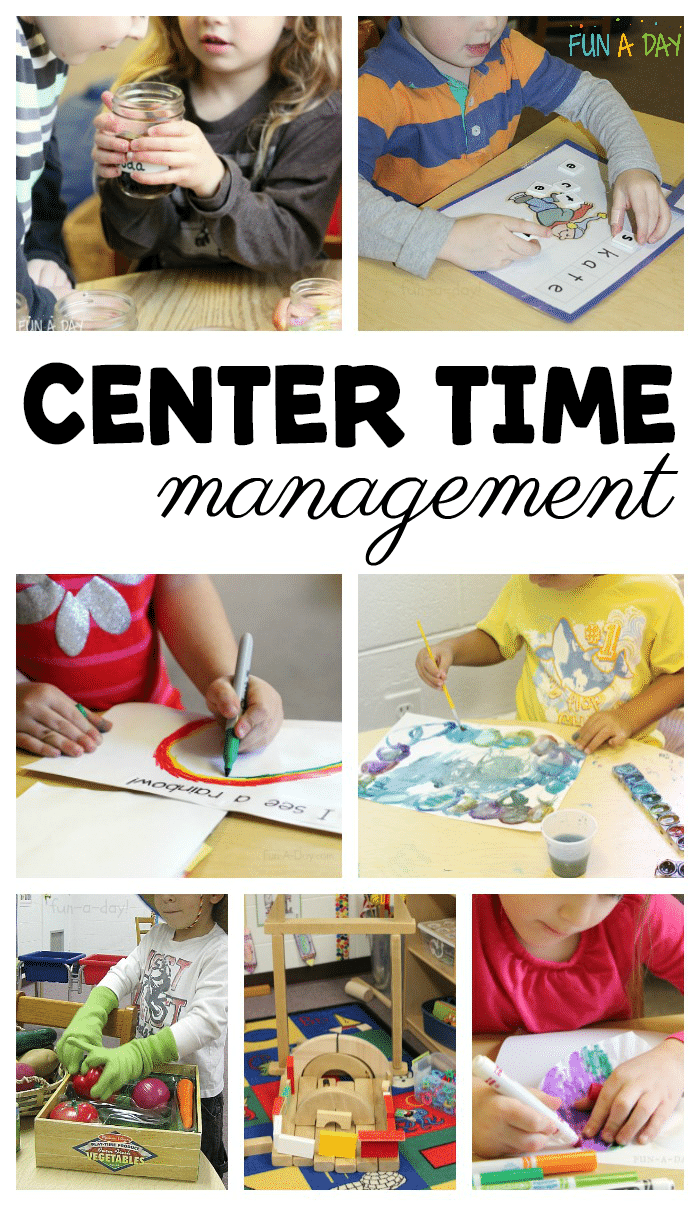
Be sure to check out our Early Childhood Education Centers Resource for an in-depth teachers’ guide and center cards.
Methods for Managing Early Childhood Center Time
As I mentioned earlier, these are just some ideas for managing center time in your classroom. I’ve used each of them, and I think there are pros and cons to each way of doing things.
Over time, I’ve also noticed that my thoughts have changed. I used to prefer one method of center management, but found that another works so much better for my students.
So remember that you aren’t married to just one way of running your early childhood centers. In fact, it’s likely best to reevaluate each year depending on the group of children that you have (and sometimes a mid-year reevaluation is in order).
Free Choice Centers are My Preferred Choice for Preschool Classrooms
With open-ended, free choice centers your students can determine which centers they want to visit during center time.
You, as the teacher, determine which centers are available to the kids during this time. You’re also responsible for what materials are within each of these centers. Basic center rules still need to be followed, as well.
At first, I have to admit I was a little hesitant to embrace free choice centers. Having started out as a kindergarten teacher, I was used to a bit more teacher-directed center time management. I’ve since gotten over that hesitation and fully embrace them. I also came to realize that these centers don’t lack structure – they’re just organized a bit differently than I was used to.
When I first started out in pre-kindergarten, I kept the free choice center time towards the beginning of the school year. So from September through December or January, we had free choice centers. After that, I instituted structured, grouped centers.
Where I stand now, I think free choice centers are my personal favorite for preschool classrooms. I’ve outlined the benefits of them, along with management suggestions, here in a separate post.
Related: Preschool Schedule for Half-Day Preschool
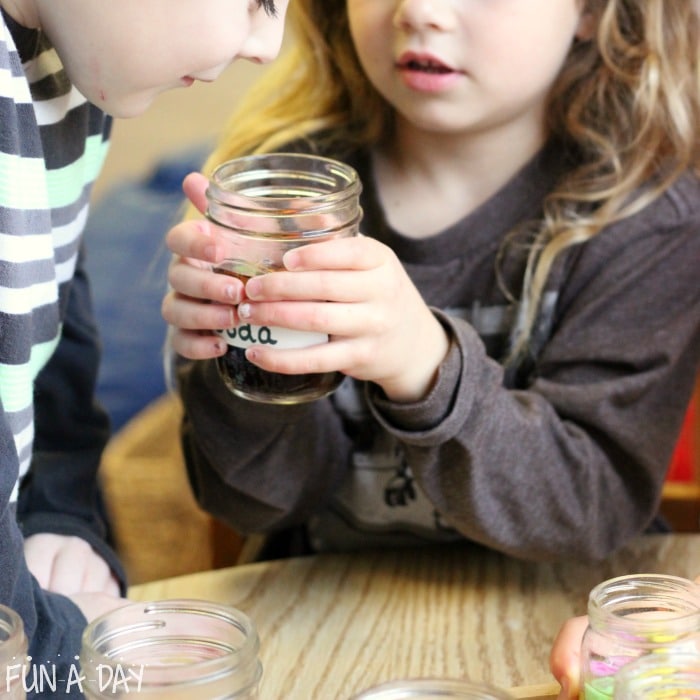
Structured, Grouped Centers for Kindergarten Center Time
Another way you can manage your centers is a bit more teacher-directed. I think this worked very well during kindergarten center time, and they’re likely my favorite for that age group.
I’ve used it in the preschool classroom too, but I wouldn’t suggest using it with young preschool children (under age 4). Most of my pre-kinder students responded well to it during the latter half of their preschool year. That being said, I now think that open-ended centers (as mentioned above) works best for preschool children.
This method of center organization and management starts with groups of students. Depending on the number of children in your classroom, this could be four or five different groups. I preferred to keep them to four groups if at all possible.
Each group of children then has certain centers to work through each day, Monday through Thursday (if you have five groups of kids, it would go Monday through Friday). As I mentioned above, I liked having four groups so we could turn Friday into “Fun Friday Centers”.
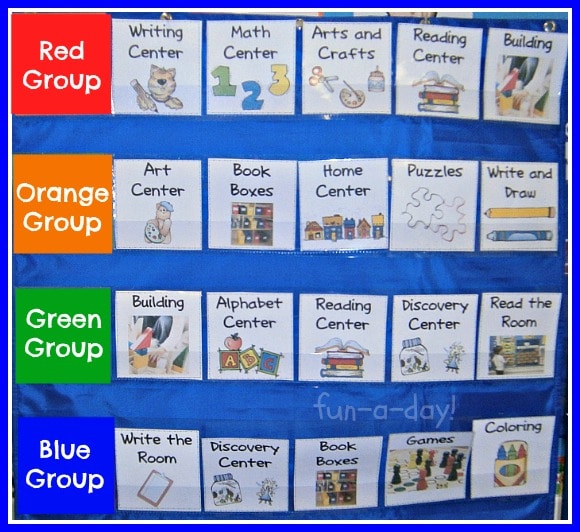
The students can still work at their own pace, and there’s flexibility built in to work independently or with peers from within their own group. They can also decide how long to remain at each center. Once the kids have completed their “must do” centers, they are allowed a few different center choices.
However, the children don’t have a choice as to which centers they need to go to. They also aren’t given the choice to go to the centers in a different order.
There will be a follow-up post explaining this more in-depth soon.
Related: Working Together to Create a Classroom Community
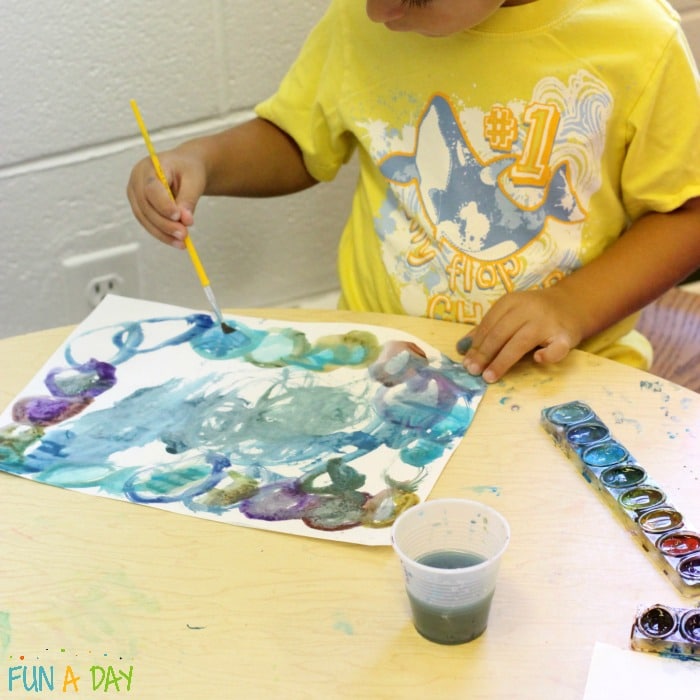
Rotating Center Management
One final center management method I’ve used is more rigid than the other ideas I’ve already mentioned. I rarely used rotating center time with my preschoolers, but I did use it with my kindergarten students from time to time.
With rotating centers, you split the children into groups. The number of groups usually depends on how many centers you have available at the time. For example, if you have six center areas open, it would make sense to split the kids into six groups.
Once the children are split up, you assign each group to a center to start out in. Each group works and plays in their assigned center for a set period of time.
When time is almost up, you deliver a five minute warning. Once those five minutes are over, every student cleans up and lines up by their centers (still in their groups). You could use a bell or a maraca to tell the kids it’s time to clean up their areas.
Then you direct each group to the next center to go to. I usually had the kids moving in a general clockwise direction, as that was just easier for me. Once every group had been through every center, it was time to move on to a different part of the day.
During my first couple of years as a kindergarten teacher, we often used this rotational method of center time management. My teaching partner and I even had a sweet chant the kids would say before moving on to the next center – “We’re not 5, we’re not 4, we’re not 3, we’re not 2, we’re number 1! We’re number !!” Nothing fancy, but the kids enjoyed it.
Related: Preschool Classroom Tour
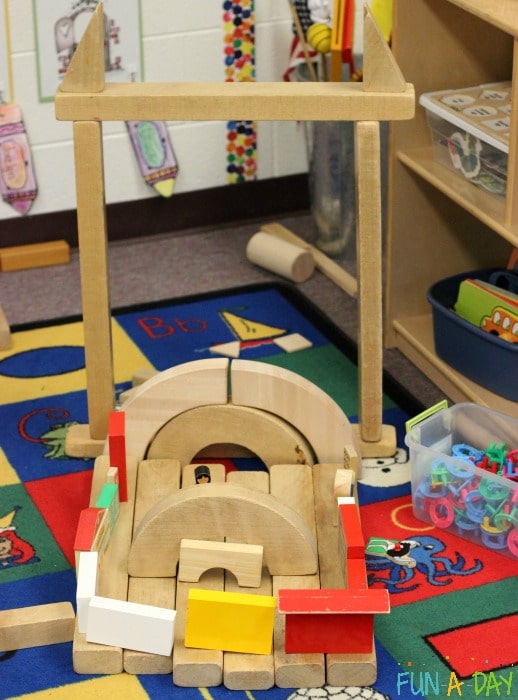
How Do You Like to Manage Center Time?
Now that I’ve shared three different center management ideas, I’d love to hear what you have to say. Do you have a favorite way of handling center time in your early childhood classroom?
If you’re new to centers, I hope that you were able to grab an idea or two to apply to your own classroom. Feel free to leave questions or comments below.
Please note this post was originally written January 11, 2013. It’s been updated to provide more information and add a few new photos.
Materials for Centers
Regardless of how you choose to run center time in your classroom, you’ll need some materials to keep you organized. Organization looks different for everyone, but I have a few storage suggestions that help keep me on track. Here they are (I may get commissions for purchases made through links in this post):
The list includes just a few of my own preferences. Find the products that work best for you and invest in them. Staying organized helps keep me calm during the school days. I think it will help you, too!
Amazing Resource for Your Early Childhood Centers
I’ve had many readers looking for help with centers, as well as requests for center cards – which led to the creation of this centers pack. If you’d like all the whys, hows, and to-dos in one place, along with a ton of printable center cards and signs, you need to check out this Preschool Centers Resource. Keep in mind, this would work great in other early childhood classrooms too! Below the photo you’ll see what comes in the 250+ page pack.
What’s Included
50 page planning guide
This teacher guide delves into what centers are, why they’re important, ideas for managing centers, how to set up centers in preschool, ideas for stocking centers, and how to introduce them to your students.
This planning guide would be great to print out and add to a teacher binder, or get them printed and bound separately to keep for reference in the classroom.
Printables for managing and labeling centers
There are a wide variety of centers included in these printables. This way, you can pick and choose what you need for your own classroom each year.
Here are the printables included along with the teacher guide:
- Large Center Signs
- Square Center Cards
- Center Choices Checklists
- Center Rules (with an editable option)
- Large Centers Signs (with room for students to add Name Cards)
- Editable Student Name Cards
- Center Sign Up Sheets
- “Work in Progress” Signs
- “Book Hospital” Labels
Get your Centers Guide on Preschool Teacher 101
Also available on Teachers Pay Teachers
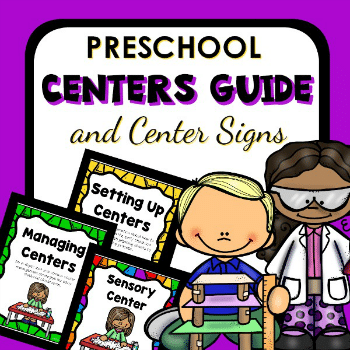
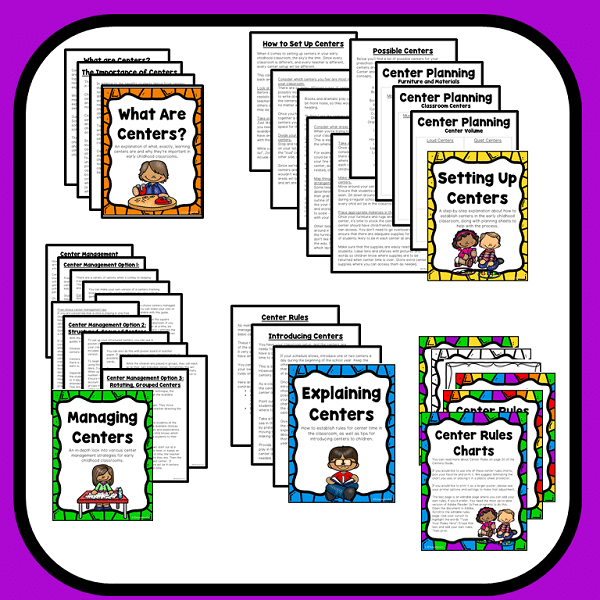
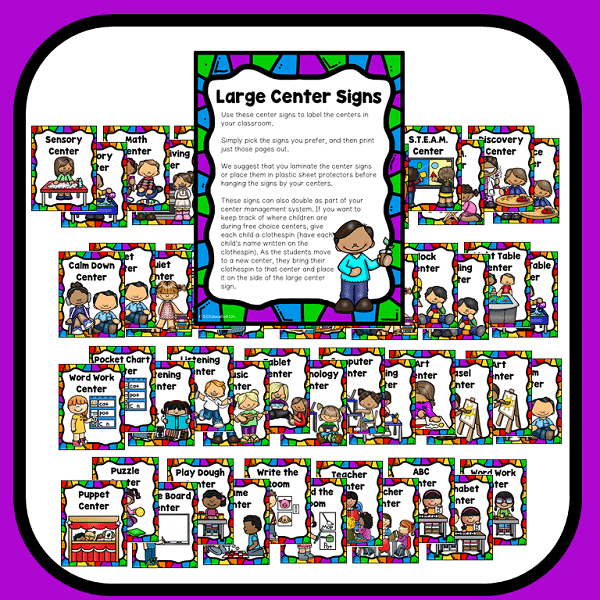
Hi, I love your post on centers. I have recently taken over a 10 student pre K classroom. I would like our center time to have a little more structure and have the kids get more out of them. As of now not a one uses the writing center, so I feel like your chart would be very helpful. Can you tell me how you incorporate your small group activity (daily art project)?
Thank you
Hi Maya,
Thanks so much for stopping by and taking the time to comment on my centers post. I incorporate the small group activities in a couple of different ways. Usually, the small group activities with a teacher or an assistant are focused on an art project or a math/literacy activity.
Sometimes I just call individual (or small groups of) children away from their centers to work with me. In this case, there is no specific center card on the chart for what I’m doing. This allows me to call however many children I have time for without being concerned about how long my activity takes. Also, this allows me to call a mixed group of children. For instance, maybe I’m working on literacy one week. I can call those children who need extra one-on-one attention and just be focused on them. I can also call a small group of children who are at the same level for a writing lesson or guided reading.
Other times, I am sitting at their first center activity. In this case, there is a center card on the center chart for my activity. For instance, maybe I’m leading the “Art Center” activity one week. That means that each day, I would only do the art project with the group listed next to the “Art Center” on the center chart. This works best for art activities that are labor-intensive for the kiddos. It also frees up time at the end of the centers for me to walk around, observe how the children are doing, and just talk to the students.
I hope some of this helps. Thanks, again, for stopping by!
thanks for this amazing ideal.
Thank you so much for your wonderful ideas. I am a first year teacher, and teach in an inclusive pre-k classroom with up to 20 kids – so finding the perfect way to run centers has been a challenge of mine this year! When you move to more structured groups in January, do you require they stay together as a group before moving on, or do you let them move to the next center independently? Thanks again!
Kara, you totally made my day! 🙂 Thanks for the kind words. Personally, I let the children move at their own pace within the more structured centers. Some teachers prefer the children move in a group, but that doesn’t work well for me. Some kids end up rushing to keep up, while others have to sit and wait. I do expect them all to do their best, so there are times when I tell a child to go back and take his time on a center activity (sometimes they rush to get to the centers they love). I hope this answers your question. Let me know if you have any more! 🙂
Thanks so much, Cindy! As of right now, I don’t have a printable that’s available. I need to check the copyrights of the clip art I used. Once I know the details of that, I can try and share a free version of it!
Hi – I was wondering if you have your cards that are printable for your centers. They are wonderful and I’d love to use them in my new pre-k classroom. Thanks so much!
Hi Stefani! I did make my own cards. I’m working on a version to share with you! 🙂
Hi. I am so excited to see these postings. I am really struggling. I have 23 Prek, and it is getting wild. Do you have a copy of your schedule? Of my students 13 come 5 days, 17 4 days and 23 3 days. How would you set up centers? I have an aide but this is her first year too. Funny, cause on my days I feel like my training has gone out the window. Love it but it is hard. Chemistry of the room is so different this year.
Isn’t it amazing how the chemistry of the room can change from year to year?? I’m going to write a post about my schedule soon, I think — I’ve had conversations about it with other readers. With children coming on different days, I know organizing centers can be a bit more difficult. For me, I would have as many interest areas/centers that appealed to the children (obviously, you’d have to take into account your day and the space you have in your room). Depending on the time of year, and the children, I would try the more organized approach that’s mentioned in this post. But I would keep the activities in the centers as broad as possible so the children enjoy their learning time no matter what day they come to school. I hope this helps a little bit! 🙂
Hi, this post is really informative! Right now, I do 3 centers with a teacher at each center and use a timer to rotate. So your students move independently through each center- they start as a group, but they can move individually? So at a given center two groups may be represented? I’m curious as what kind of tasks may be in the block area for the children to complete. Thanks!
Hi, I love your ideas of organizing centers. How would you do centers in a classroom of 8 kids. We are a half day program. How long in your center time?
Thanks, Teresa! Right now, my center time is about an hour and a half. With 8 children, I’d likely pick one activity a day that I’d prefer they do. After that, I’d encourage them to make some free choices from available centers. Another idea is to let the children work in pairs for a few activities before moving onto free choices. I hope this helps you out a little bit. I would love to hear your thoughts about it!
Thank you so much for the detail involved. I am wondering when they are in the structured time of the year, are they supposed to complete a specific task in each center or may they choose any activity in that center and then move on? Thanks!
Hi Kay! That’s really up to you. Sometimes I have a specific task for the kiddos, but other times it’s completely up to them. 🙂
Hi Mary Catherine!
So glad I found your website! You have great ideas to share! I’m interested in what the centers “Read the Room,” “Write the Room,” and “Book Boxes” consist of. I’m always looking for more creative centers!
Thanks so much, Emily! Read the room consists of walking around and finding words and names they recognize. A lot of the time, the kids also choose to do our calendar. Write the room is walking around and writing (or attempting to write) down words and letters they see in the classroom. Book boxes contain the books we make together throughout the year. I have more information about book boxes here — https://fun-a-day.com/book-boxes/. I hope that helps!
Oh, Sharon, thanks so much for your kind words! I actually made most of the cards myself. I’ll look through my files to see if I have a secure way to share them with you.
Love your centers ideas. I’m new doing the vpk class. I have 10 students that I will be having. My class is only half day, and my school is private and they have a schedule that gives me short center time. How can I get an idea of a schedule for half day class? And do you do arts and craft daily?
Hi Haydee! Here’s a recent post about my class’ preschool schedule — https://fun-a-day.com/preschool-schedule/. Yes, I include arts and crafts during centers every day. Sometimes it’s as simple as paper and crayons, while other times we do more in-depth art projects that take multiple days. I hope that helps you out a bit!
Hello there!! I am teaching 3’s for the first time this year and I am having to learn that less structure is more appropriate 🙂 In your opinion would you just let them have free centers, or would you rotate them at three years old? There will be Myself and an Aid and up to 16 children for a full day!
Hi Beatrice! I’d likely focus on more free choice centers with three year old kiddos. I’m not a huge fan of rotating through centers, even with the older children. Even with the more structured management system, the kids can work through centers at their own pace and interest levels. I hope your year goes well! 🙂
Love the center ideas. Do you start these st the beginning of the year and how do you introduce them at the beginning at f the year? We have a team limit on our crntetd but I may be able to reduce the number of activities.
Thanks so much, Ruthann! Yes, I start center time from the beginning of the year. I introduce, explain, and model the centers a lot those first few weeks of school. I explain my expectations each day and supervise/interact with the kids daily to make sure they understand what to do during centers. I hope that helps!
I’m curious about the group that goes to the “building” center first. Do you have a task for them to complete there? And I can see several of my kiddos getting there and never making it to the second center, much less the other 3! How do you work through that? Thank you!
Love your information. Question what do you do on Fun Friday
Hello. I teach pre k at a private school that drop off starts at 8:30 and pick up 11:30. All children arrive by 9:00. Right now we do Mon and Wed writing in the morning until 9. 9 circle Time and 9:30 small groups. 10:15 snack. 10:30 recess. 11:00-11:30 review or activity. 11:30 home. I was wondering if you had any suggestions on how we could incorporate our centers better.
Hi,
I love your centers ideas. I work in a classroom of up to 24 and the teacher is trying to incorporate centers. The challenge seems to be finding the flow of the groups moving to each center. Classroom management becomes challenging for this age group in a structured environment. Any of the substitute jobs I’ve been on in the pre k setting seem to successfully incorporate centers as their structure. How can this type of structure be less chaotic for the teacher?
So glad to see this on pinterest. As I was reflecting on my current class (12 boys/3 girls who are “tom-boys”) I had decided to rethink centers for the new year. Nothing “girlie” is going on in my room! I noticed the children go to blocks during your 4 day rotation, but not to the dramatic play area. Is this reserved for fun Friday’s?
oops………looking at your rotation schedule again, I see the home center!
I found your site through Pinterest. I have to say that I am excited to read a perspective I’ve forgotten. Thank you so much for reminding me of how easy it is to set them up. And I really liked your signs. Did you make your center signs? (write room, read room, etc…) I really liked how you worded each one.
Thanks so much, Samantha! Yes, I made the signs myself. I’m working on creating some that I can share with awesome readers like you!
Hi! Thank you for this post. Can you tell where to purchase the chart pictures under the structured kindergarten part? I think that method will be the best for my current class and I really like the set up of that chart.
Hi Samie! The chart pictures are super old, but I made new ones and they’re a part of the big centers planning guide shared at the bottom of this post. You can check it out HERE to see what’s included. 🙂